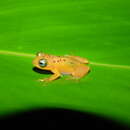Description
provided by AmphibiaWeb articles
Raorchestes manohari is a small-sized, slender reed frog with an average adult snout-vent length of 17.57 - 18.06mm. The head is slightly longer than it is wide and the space between the orbits is larger than the upper eyelid. It has distinctive eyes with horizontal elliptical, silvery blue irises with black reticulations. Tympanum is indistinct with a supratympanic fold extending from outer eye to forearm. The forelimbs are short compared to length of the hands. Subarticular tubercles are rounded and fused and the toe/finger discs are well developed. Webbing is present but underdeveloped. Skin is glandular (Zachariah et al. 2011).Raorchestes manohari is a particularly distinct Raorchestes frog. The only potentially similar species are R. luteolus and R. ochlandrae, from which R. manohari can be distinguished by its relatively small adult size (snout-vent length 17.57 - 18.06 mm). Additionally, it has an indistinct tympanum and a blunt nose that is slightly longer than the diameter of the eye. It can also be distinguished by the dark brown spotting on an otherwise yellow dorsum and its advertisement call (Zachariah et al. 2011).In life, R. manohari has a bright yellow granular dorsum with brownish black spots localized on the upper half of the frog. Limbs and digits are all uniform and the ventral side of the frog is a lighter whitish color. In preservative, the yellow dorsum turns a pale white with the same brownish black spots on the upper half while the ventral side is still a uniform white (Zachariah et al. 2011).The species authority is Zachariah, A., Dinesh, K.P., Kunhikrishnan, E., Das, S., Raju, D.V., Radhakrishnan, C., Jafer Palot, M. and Kalesh, S. (2011) Nine new species of frogs of the genus Raorchestes (Amphibia: Anura: Rhacophoridae) from southern Western Ghats, India. Biosystematica, 5(1): 25-48 Raorchestes manohari was named for T.M Manoharan, the Principal Chief Conservator of Forests in Kerala. Additionally, ‘manohar’ is a Sanskrit-derived word meaning ‘beautiful’ or ‘captivating’ in many Indian languages.
- Kishwan, J., Venkataraman, K. 2011. Critically Endangered Species of India. Ministry of Environment and Forests. Government of India. Accessed April 2013 from http://envfor.nic.in/downloads/public-information/critically_endangered_booklet.pdf
- Zachariah, A., Dinesh, K.P., Kunhikrishnan, E., Das, S., Raju, D.V., Radhakrishnan, C., Jafer Palot, M. and Kalesh, S. (2011) Nine new species of frogs of the genus Raorchestes (Amphibia: Anura: Rhacophoridae) from southern Western Ghats, India. Biosystematica, 5(1): 25-48
Distribution and Habitat
provided by AmphibiaWeb articles
This species is found at about 600 m elevation amidst highland reeds in the Western Ghats of India. Specifically, it has been found in various parts of the southern Indian state of Kerala including the Bonacaud tea estate, Thiruvananthapuram district, and the Shendurney Wildlife Sanctuary in the Kollam district (Zachariah et al. 2011).
Life History, Abundance, Activity, and Special Behaviors
provided by AmphibiaWeb articles
Has a distinctive weak five to six “tick-tick” note advertisement call (Zachariah et al. 2011).
Life History, Abundance, Activity, and Special Behaviors
provided by AmphibiaWeb articles
No threats are described specifically for this species but other Raorchestes species with similar ranges have been declining due to extensive degradation of their habitat by large-scale tea and eucalyptus plantations as well as habitat conversion to resorts and the like to accommodate the fast-growing tourism industry (Kishwan and Venkataraman 2011).

